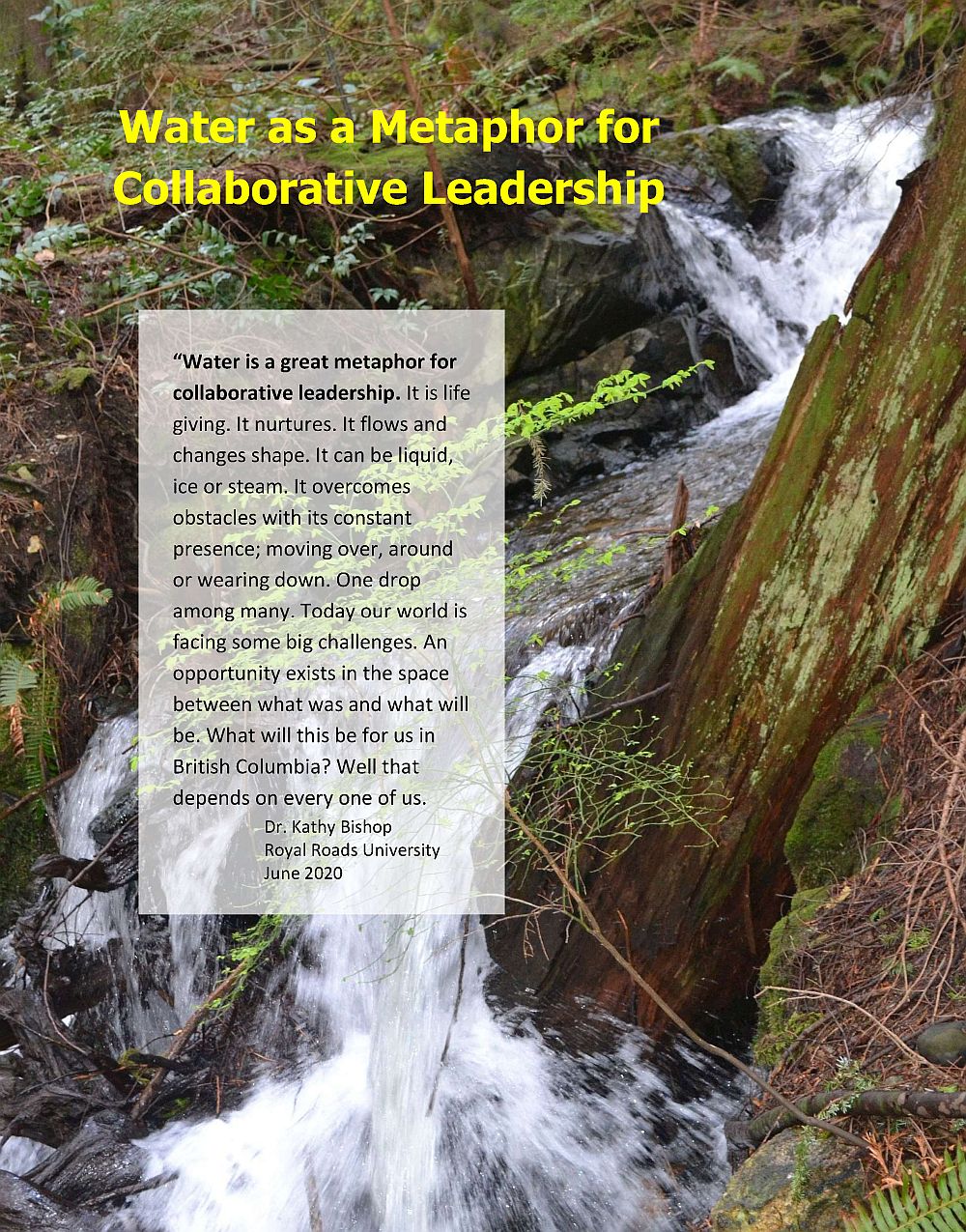DRINKING WATER & WATERSHED PROTECTION IN THE NANAIMO REGION: “The Millstone River and EAP (Ecological Accounting Process) project are a vignette for the bigger mandate of the DWWP. Both demonstrate project level partnerships with stewardship groups; as well as partnerships across local government jurisdictions,” stated Julie Pisani, DWWP Program Coordinator, when the Partnership for Water Sustainability’s case study report on the Millstone River EAP Project was approved by the RDN Board (April 2021)
Note to Reader:
On April 27th 2021, the RDN Regional Board established a BC-first when it approved this recommendation by staff: “That the Millstone River Ecological Accounting Process report be used to inform future Corporate Asset Management Planning.” Millstone River is the first of six Stage 3 case studies to be completed under the program for testing, refining and mainstreaming EAP, the Ecological Accounting Process. This is a methodology for financial valuation of ecological services.
In May 2021, the Partnership for Water Sustainability released Millstone River – A Natural Commons in the Regional District of Nanaimo: Operationalizing the Ecological Accounting Process for Financial Valuation of Stream Corridor Systems within an Asset Management Plan, the fifth in a series of reports on EAP demonstration applications.
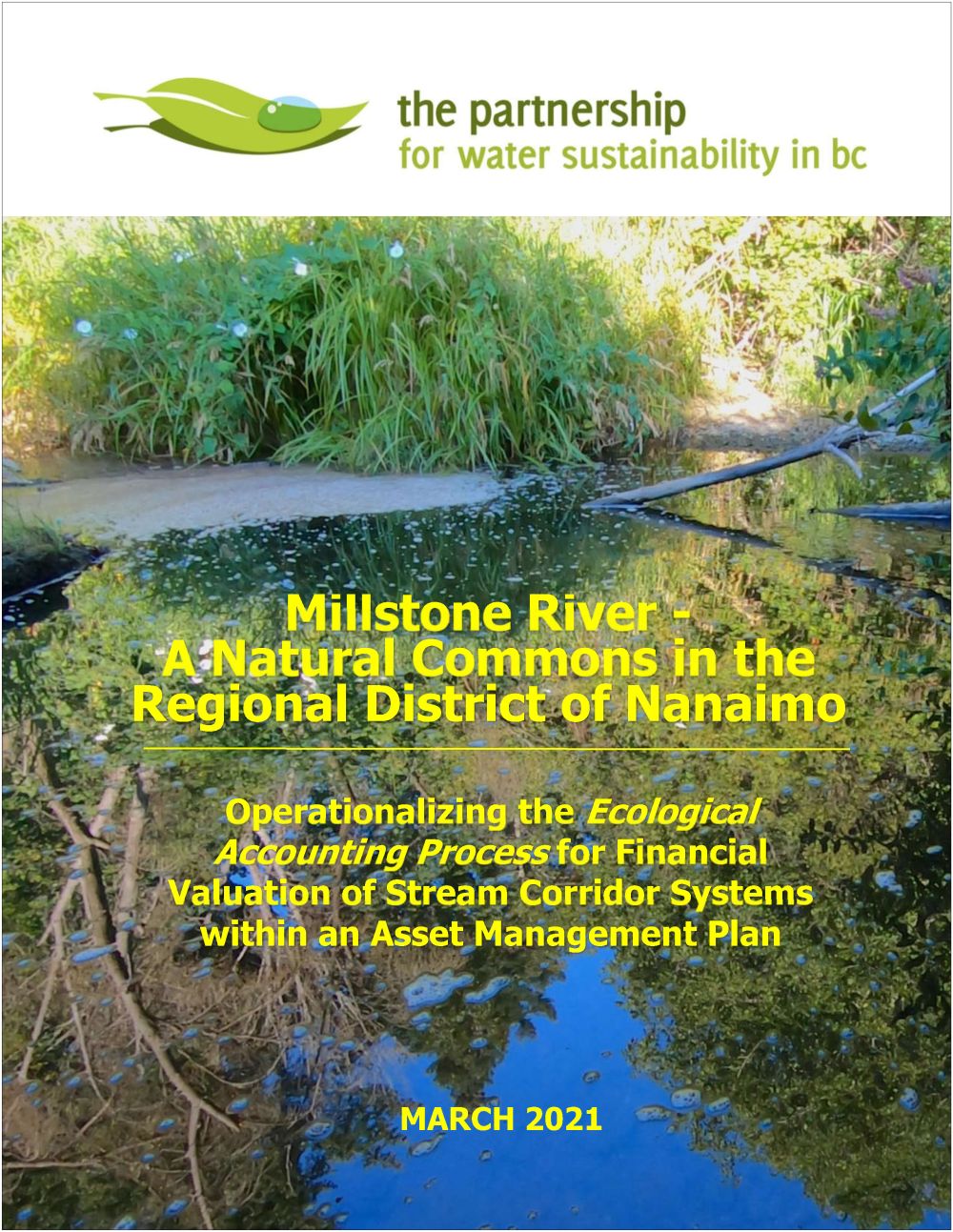
Ecological Accounting Process is a Game-Changer
“Five years ago, the Partnership for Water Sustainability introduced the vision for EAP, the Ecological Accounting Process. The driver for EAP is degradation of stream channels and streamside protection areas. EAP addresses the elephant in the room which is the unfunded cost (hence liability) to protect, remediate or enhance stream systems in urban and rural landscapes,” stated Kim Stephens, Executive Director, Partnership for Water Sustainability in British Columbia.
“The EAP methodology and metrics have been developed to support Asset Management for Sustainable Service Delivery. Moreover, EAP is a pillar of the whole-system, water balance approach to integration of land and water management. The program for Sustainable Creekshed Systems, through Asset Management is a foundation piece for the Water Sustainability Action Plan for British Columbia. In turn, the Action Plan is nested within Living Water Smart in British Columbia.”

EAP Bridges a Gap
“EAP satisfies a local government need for a financial methodology and metrics for valuation of ecological assets. Most importantly, EAP interweaves the financial, social and ecological perspectives within a single number.”
“ The NCA value puts the discussion of natural assets (stream systems) on an equal footing with constructed assets (physical infrastructure). This is a game-chamber. Environmental planners now have a starting point for a conversation with engineers and accountants about the services that natural and constructed assets both provide.”
The NCA value puts the discussion of natural assets (stream systems) on an equal footing with constructed assets (physical infrastructure). This is a game-chamber. Environmental planners now have a starting point for a conversation with engineers and accountants about the services that natural and constructed assets both provide.”
‘It has been five years of determined effort by EAP Chair Tim Pringle and his team to test, refine and mainstream EAP. This has been accomplished through collaboration with a group of local government partners willing to break new ground. Each EAP project advances refinement of the methodology.”
“Each case study is unique in that partner communities frame creekshed-specific questions to be addressed by their EAP application. Each case study yields key lessons and results in fresh observations. Each has supported the depth of analysis for subsequent EAP applications.”
THE MILLSTONE EAP DEMONSTRATION APPLICATION IS THE FLAGSHIP PROJECT:
“The Millstone project provided the RDN, the City of Nanaimo and local stewardship group Island Waters Fly Fishers with the opportunity to get a real measure that accounts for the value and worth of the Millstone River stream corridor in asset management planning. They now have the numbers to make the case for M&M of the Millstone.”
“The Millstone River EAP project has provided the RDN with a path forward so that it could account for and operationalize M&M of stream corridor systems across the region. This would be done under the umbrella of its Corporate Asset Management Plan. This would be a BC-first.”
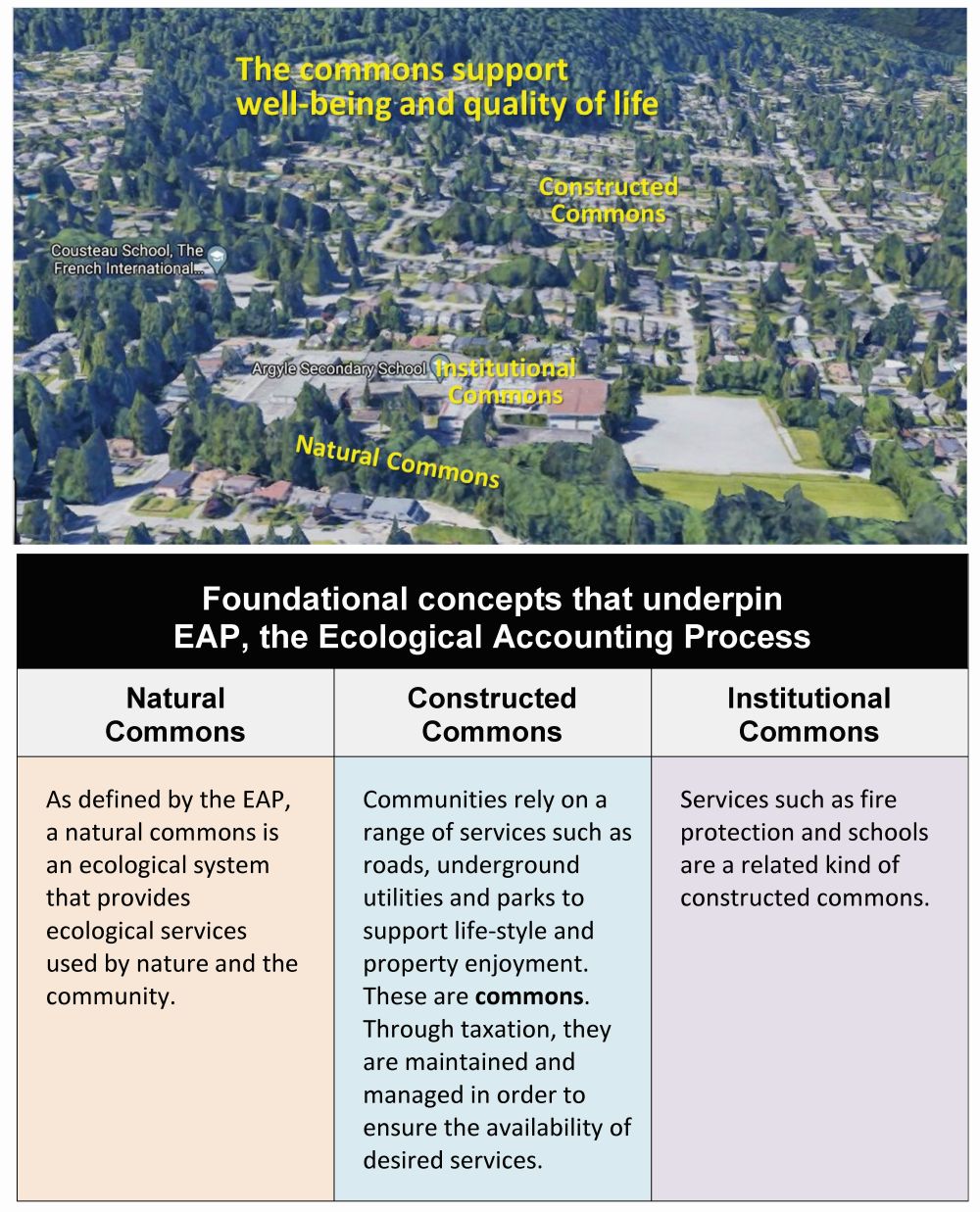
TIM PRINGLE: A Stream is a Land Use and provides a
“Package of Ecological Services”
“The EAP methodology focuses on the historical and current land use practices that have changed landscapes, modified hydrology, and have led to present-day community perceptions of the worth of the stream or creekshed and the ecological services it provides. A whole-system understanding is the starting point for developing meaningful metrics,” states Tim Pringle.
EAP Metrics Focus on Parcel (Land Only) Assessments
“A central idea of the EAP methodology is that a stream is a land use. If the stream did not exist, the land it occupies would be in the same use as nearby development. A stream is a land use because the area of the setback zone is defined in regulations.”
“In turn, EAP describes this land use as the Natural Commons Asset, or NCA. And furthermore, a proxy financial value can be assigned to the NCA using BC Assessment data for abutting or adjacent parcels.”
“BC Assessment separates land values from the worth of improvements. BC Assessment data reflects the influence of buyer and seller behaviour over time. BC Assessment values for classes of property are based on completed real estate transactions. They are not appraisals.”
“The NCA provides a ‘range of uses’ desired by the community. These are described as the package of ecological services. They are the benefits and values that the stream system, or NCA, provides to the public: drainage, recreational and cultural value, and critical habitat.”
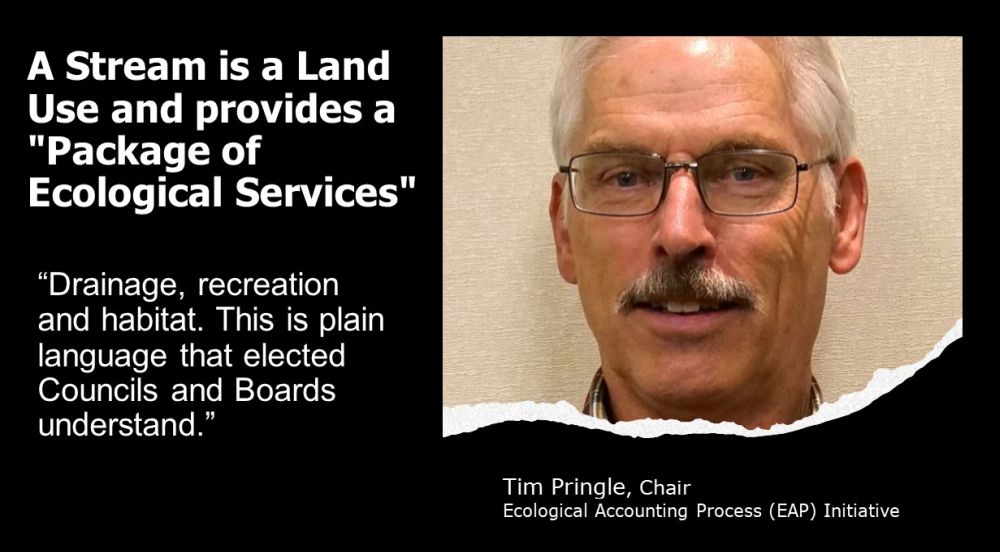
Millstone River EAP Research Objectives and an
Unforeseen Outcome
“The Millstone River research application of EAP addressed two questions,” continues Tim Pringle. “What influence does the stream as an ecological system (as a natural commons) have on urban and rural land use near the stream system; and does the stream influence the utility and financial value of parcels? ?” And, how do land uses influence the stream?”
“The research and analyses confirm that in recent decades the community has gained an understanding of the Millstone River corridor as a natural commons or ecological system offering a range of uses or services. Changes to official plans and regulations provide measures to improve maintenance and management of these natural commons.”
The research had three objectives:
“The research objectives were: “The research objectives were: Establish a measure of stream corridor worth to the community based on expenditures and investment made to maintain and enhance the stream condition. Quantify the financial value of the stream corridor as a Natural Commons Asset (NCA). Determine whether the stream influences the assessed values of parcels that abut or are adjacent to the stream.”
“In addition to fulfilling all three objectives, and this was an unforeseen outcome of the EAP research application, we produced a benchmark assessment of woodlands and native vegetation within the regulated riparian setback zone of the Millstone stream corridor – that is, the Streamside Protection and Enhancement Area (SPEA).”
“The EAP analyses provide the City of Nanaimo with specific financial as well as social and ecological measures for its historical investment in the Millstone Greenway over 20 years. Through their ongoing collaboration, the City and RDN will be able to consider future M&M strategies based on the entire Millstone system.”
“The combination of NCA metrics and riparian assessment has provided the two local governments with a starting point for building early support, for long-term and target-based strategies, for systematic M&M investment in restoring riparian woodlands and native vegetation for the full width of the regulated SPEA setback zone. This is huge!”
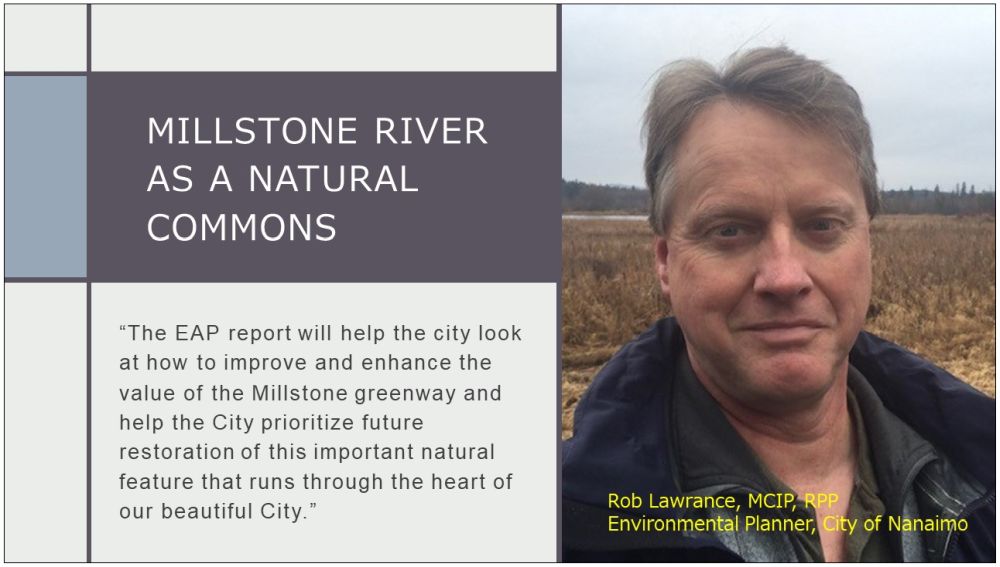

JULIE PISANI: Drinking Water & Watershed Protection (DWWP) program sets the context for Millstone River EAP Project
“The Millstone River and EAP project are a vignette for the bigger mandate of the DWWP. Both demonstrate project level partnerships with stewardship groups; as well as partnerships across local government jurisdictions,” states Julie Pisani, DWWP Program Coordinator.
Collaboration, Community Outreach and Stream Stewardship
“The stewardship thread that is pulled through the Millstone EAP project centres around the involvement of Bernie Heinrichs. His group, Island Waters Fly Fishers, has been involved in the RDN’s surface water quality sampling program since 2011. There was little data at the start, but now with longer datasets we start to see trends and are able to better understand the health of our region’s creeks.”
“The data findings then direct efforts – for example, riparian area education for farmers and streamside landowners. Then it leads to restoration, often led by community volunteers which we support through stewardship seed funding. Now EAP represents the potential for innovative policy that aligns stewardship with the novel aspect of ecological accounting.”
An Overview of the Millstone River EAP Project:
“The EAP methodology reflects the understanding that landowners adjacent to the stream corridor and setback zone (30 metres on both sides of the stream) and the broader community share responsibility for and benefit from the condition of the stream as well as the financial and ecological value of the land it occupies.”
“The study’s intent was to pilot the EAP in the context of the Millstone River, an important ecological feature in the Nanaimo region that includes RDN Electoral Area C upstream and City of Nanaimo downstream, to test the methodology and take away learnings for further refinement in future applications.”
Take-aways from Millstone River EAP Project
“Engaging a project steering committee and conducting a community survey on how landowners nearby to the stream value its presence and understand its worth, were important qualitative inputs alongside the number-crunching. Through this process, the importance of riparian vegetation was highlighted and led to an additional desktop assessment of riparian cover in the river corridor, which provides a high-level basis for strategizing where to prioritize investment in restoration of riparian woodlands to improve the health and functioning condition of the river.”
“Ultimately, the study found that the 15 km of stream length from Brannen Lake to Nanaimo Harbour, with 7 km in the City of Nanaimo and 8 km in Electoral Area C, had the combined Natural Commons Asset value of $5.5M per kilometer or $79.7M total, based on BC Assessment data.”
“It also found that community investment per year (based on the past decade) is roughly $560,000 between the City and the RDN – including parkland purchases, infrastructure improvements, stewardship and monitoring. This shows there is already a level of investment as an expression of what the river is ‘worth’ to the community.”
“The report suggests a general framework for local governments to consider in using the lens of ecological accounting within Corporate Asset Management Plans to prevent degradation and improve stream corridor condition for the benefit of the community at-large. It is not the only methodology to account for natural assets, but it certainly increases our understanding and gives us some language and tools to advance the conversation,” concludes Julie Pisani.

About the Partnership for Water Sustainability in BC
The Partnership’s guiding philosophy is to help others be successful. When our partners and collaborators are successful, we are successful. The Partnership is led by a team of community-minded and mission-focused elders. Although many on the team are retired from their jobs, they continue their water-centric mission as volunteers.
Conceptual Framework for Inter-Generational Collaboration
Technical knowledge alone is not enough to resolve water challenges facing BC. Making things happen in the real world requires an appreciation and understanding of human behaviour, combined with a knowledge of how decisions are made. It takes a career to figure this out.
The Partnership leadership team brings experience, knowledge, and wisdom – a forceful combination to help collaborators reach their vision, mission, and goals for achieving water sustainability.
The Partnership has a primary goal, to build bridges of understanding and pass the baton from the past to the present and future. However, inter-generational collaboration is a two-way street. Minds must be open and receptive to accepting the inter-generational baton and embracing the wisdom that goes with it. When that happens, decisions will benefit from and build upon past experience.

Application of Experience, Knowledge and Wisdom
The umbrella for Partnership initiatives and programs is the Water Sustainability Action Plan for British Columbia. In turn, the Action Plan is nested within Living Water Smart, British Columbia’s Water Plan. Released in 2008, Living Water Smart was the provincial government’s call to action, and to this day transcends governments.
Incorporation of the Partnership for Water Sustainability in British Columbia as a not-for-profit society on November 19, 2010 was a milestone moment. Incorporation signified a bold leap forward. Two decades earlier, a group of like-minded and passionate individuals, including representatives of three levels of government, came together as a technical committee. Over time, this “water roundtable” evolved into The Partnership.
TO LEARN MORE, VISIT: https://waterbucket.ca/about-us/
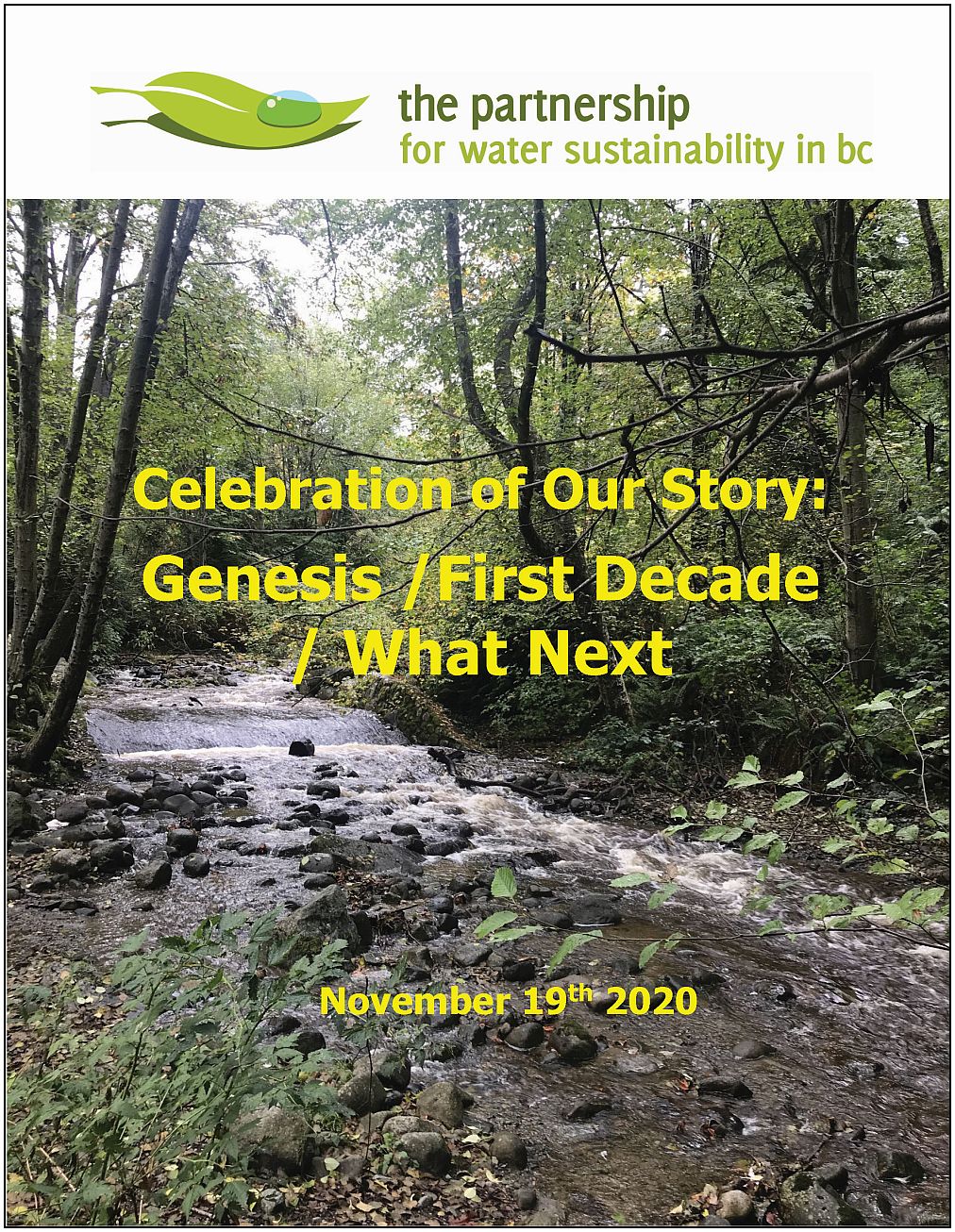
DOWNLOAD: https://waterbucket.ca/atp/wp-content/uploads/sites/9/2020/11/PWSBC_Story-of-First-Decade_Nov-2020.pdf


